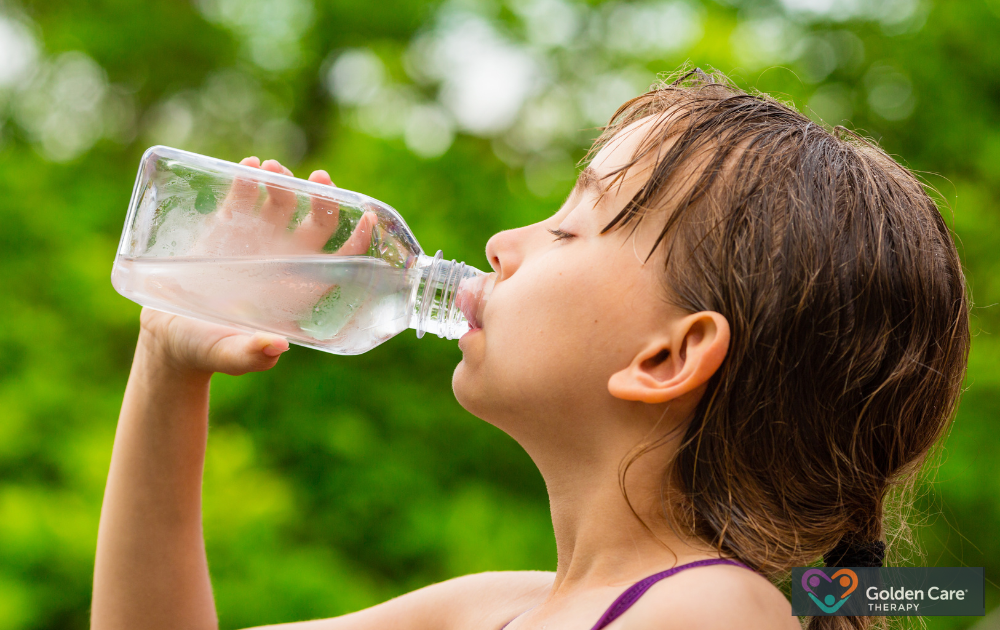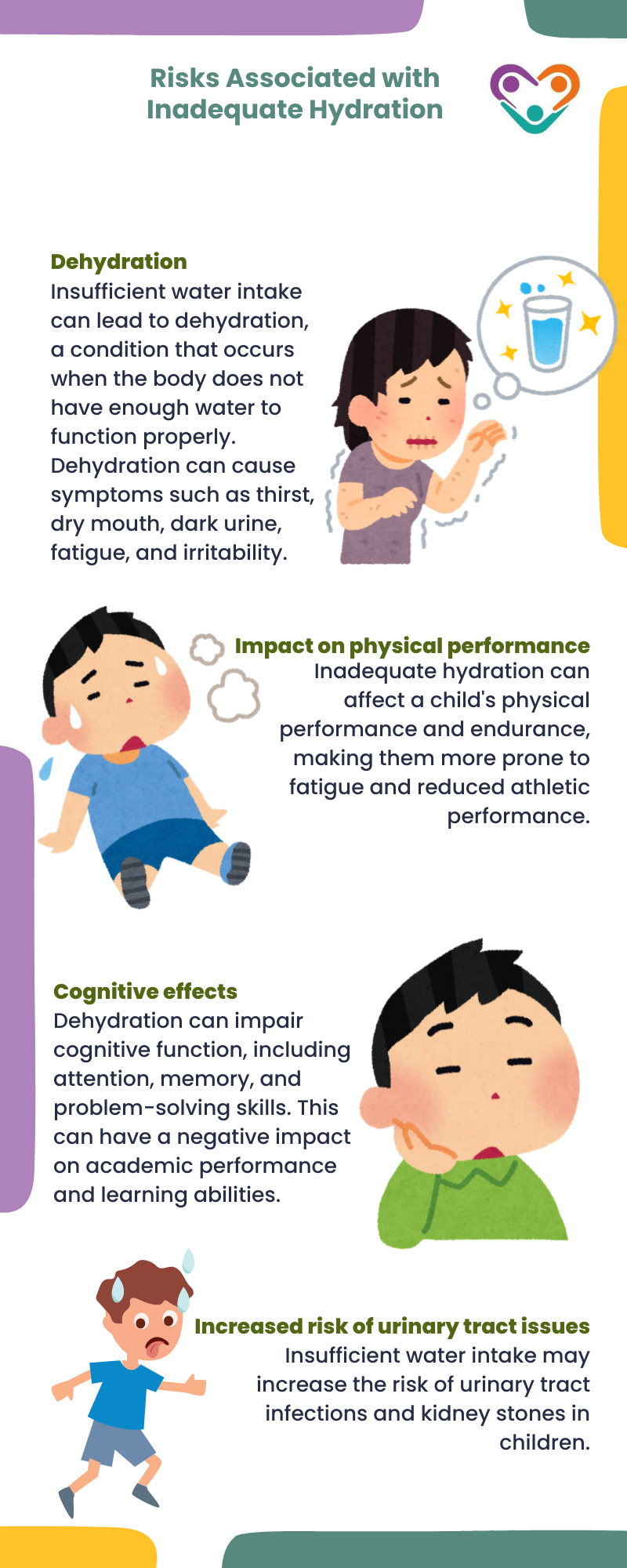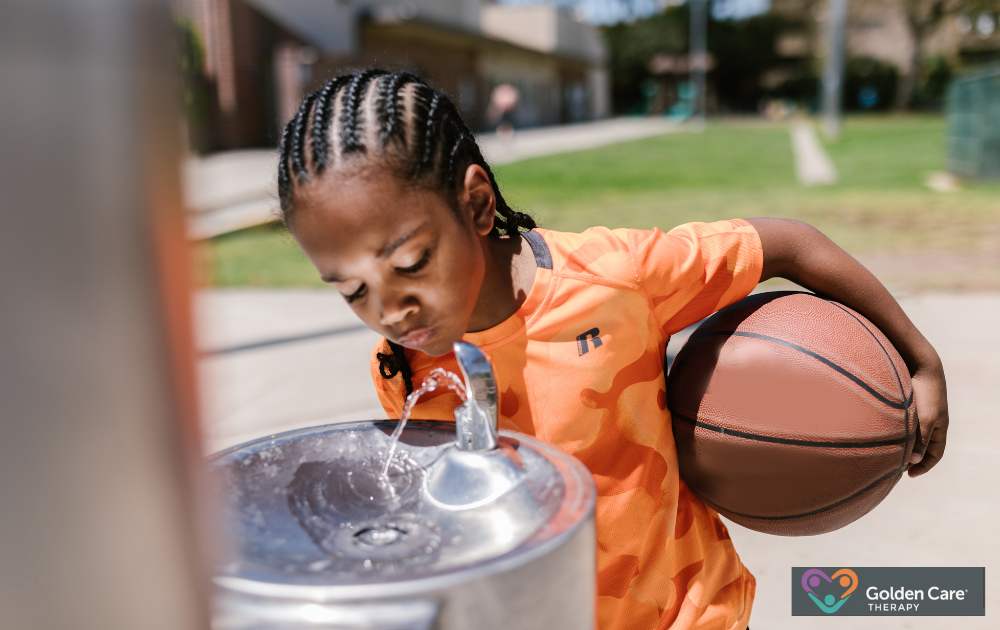Ensuring proper hydration is vital for the overall health and well-being of children, including those with autism. As an essential nutrient, water plays a crucial role in supporting various bodily functions.
But what if your child refuses to drink water? Well, let’s find out some useful solutions to that problem.

The Role of Water in Children’s Health
Water is involved in numerous physiological processes that are essential for children’s health. Here are some of its key roles:
- Maintaining hydration – Water helps regulate body temperature and prevents dehydration, which can lead to fatigue, dizziness, and poor cognitive function.
- Supporting digestion – Sufficient water intake aids in digestion, nutrient absorption, and the elimination of waste products.
- Promoting circulation – Water is a key component of blood, supporting the transport of oxygen and nutrients throughout the body.
- Lubricating joints and tissues – Adequate hydration helps keep joints and tissues lubricated, reducing the risk of discomfort and injury.
- Supporting cognitive function – Proper hydration is important for optimal brain function, including concentration, memory, and overall cognitive performance.
If children don’t consume enough water to meet their hydration needs, it can have negative consequences on their health. Some of the risks associated with inadequate hydration include the following:

To ensure optimal health and well-being, it is crucial to encourage children, including those with autism, to drink an adequate amount of water throughout the day.
Strategies to Encourage Water Intake
The problem is that getting an autistic child to drink water can sometimes be challenging due to sensory sensitivities, aversions to certain textures and flavors, and difficulties with self-care.
Fortunately, there are strategies that can be implemented to encourage water intake and ensure adequate hydration. Here are some of the most effective approaches:
Dilute Juices with Water
One way to encourage children to drink more water is by diluting their juices with water. Water is an essential nutrient that our bodies cannot survive without, and adequate hydration is crucial for children’s health.
By gradually transitioning from juice to a mix of 50% juice and 50% water, you can help acclimate their taste buds to the less intense flavor of pure water.
Over time, the mix can be further adjusted to contain a higher percentage of water until they are comfortable drinking 100% water.

Use Frozen Treats
Another strategy to encourage hydration is by incorporating frozen treats. Freeze fruits or create popsicles and ice cubes using water. This not only provides a refreshing treat but also serves as an enjoyable way to increase water intake.
The cool temperature and different textures can be appealing to children, making it more likely for them to consume water in this form.
Utilize Water Tracking Apps
Water tracking apps can be a useful tool in motivating children to drink more water. Apps such as Plant Nanny and iDrated are specifically designed to make drinking water fun and engaging. They incorporate visual stimulation and provide a sense of responsibility by allowing children to track their water intake and monitor their progress.
These apps can be a helpful reminder to encourage children to reach their daily hydration goals.
Understand Sensory Preferences and Aversions
Autistic children often have heightened sensory sensitivities which can affect their willingness to drink water. Water itself is usually neutral, but the sensory experience can be influenced by the temperature, taste, texture, and even the type of cup or bottle used.
Experimenting with different temperatures can help determine a child’s preference. Some children might find cold water more refreshing and palatable, while others might prefer room temperature or even slightly warm water. Sometimes, the neutral taste of water might be off-putting.
Adding natural flavors like a slice of lemon, cucumber, or a splash of fruit juice can make it more appealing without adding too much sugar.
The type of drinking vessel can significantly impact a child’s willingness to drink. Some children might prefer a straw, a sippy cup, or even a specific type of bottle. The texture and grip of the cup or bottle can also be important.
For example, some children might prefer a bottle with a smooth surface, while others might like a bottle with a textured grip.
Gradually Increase Water Intake
Sudden changes can be overwhelming for autistic children, so it is often more effective to make gradual adjustments. If a child is not used to drinking water, start by offering small amounts and gradually increase the quantity over time.
This approach can help the child become accustomed to drinking water without feeling pressured.
Tracking the child’s water intake can help monitor progress and identify patterns. Keeping a journal or using a hydration app can be useful tools for this purpose.
Celebrating small milestones, such as drinking a full cup of water, can encourage continued progress.

Make Drinking Water Fun and Engaging
Engagement and motivation can be significant factors in encouraging an autistic child to drink more water. Transforming the act of drinking water into a fun and interactive activity can enhance their interest. Using colorful and visually appealing cups or bottles can make the experience more enjoyable.
Some bottles have built-in features like spouts shaped like animals or favorite cartoon characters, which can make drinking water more appealing.
Incorporating play can also be effective. For instance, turning water drinking into a game, such as taking a sip every time a certain word is said during a story, can make the process more engaging.
Additionally, using rewards and positive reinforcement can be highly effective. Praise, stickers, or a small treat for drinking a set amount of water can motivate the child to drink more.
Incorporate Water into Daily Routines
Establishing a consistent routine is beneficial for autistic children as it provides a sense of predictability and security. Integrating water drinking into these routines can help make it a regular habit.
Start by offering water at specific times of the day, such as during meals, after playtime, or before bed. Visual schedules can be particularly helpful. These can include pictures or symbols that represent different parts of the day, including designated times for drinking water.
Additionally, using a timer or an alarm can serve as a reminder for the child to drink water. This approach leverages the structured nature of a routine to encourage consistent hydration.

Monitor and Encourage Fluid Intake Through Foods
Hydration doesn’t have to come from water alone. Many foods have high water content and can contribute significantly to overall hydration.
Fruits such as watermelon, strawberries, oranges, and cucumbers are excellent sources of water. Including these in the child’s diet can help increase their fluid intake.
Incorporating these water-rich foods into meals and snacks can be a practical way to boost hydration. Smoothies made with fruits and vegetables are another great option, providing both nutrition and hydration in an enjoyable form.
Address Communication Barriers
Communication difficulties are common among autistic children, which can impact their ability to express thirst or discomfort due to dehydration. It’s essential to develop strategies to help the child communicate their needs effectively.
Using visual aids, such as picture cards that depict drinking water, can help the child express when they are thirsty. Teaching basic sign language for “drink” or “water” can also be beneficial.
Additionally, observing non-verbal cues, such as restlessness or dry lips, can help caregivers identify when the child might need water.
Use Visual and Social Stories
Visual and social stories can be powerful tools to help autistic children understand the importance of drinking water. These stories can be personalized to show the child in various situations where drinking water is beneficial, such as after playing or during a meal.
Creating a story that includes their favorite characters or familiar settings can make the information more relatable and engaging.
Visual stories can include step-by-step illustrations that depict the process of drinking water, starting from recognizing thirst to taking a sip. This method can demystify the process and make it more accessible. Consistently referring to these stories can reinforce the behavior over time.
Collaborate with Occupational Therapists
Occupational therapists (OTs) specialize in helping children with sensory processing and other challenges. They can provide valuable insights and strategies tailored to an autistic child’s specific needs.
Working with an OT can help identify any underlying issues that may be hindering water intake, such as oral-motor difficulties or aversions to certain textures.
OTs can suggest exercises and activities that promote oral-motor skills, making it easier for the child to drink. They can also recommend adaptive equipment or modifications to drinking tools that suit the child’s preferences and abilities. Regular consultations with an OT can ensure that the strategies remain effective and are adjusted as needed.
Encourage Peer Modeling
Children often learn behaviors by observing others, and peer modeling can be a particularly effective strategy. Encouraging the child to spend time with peers who have good hydration habits can influence their behavior positively. This approach can be implemented in a variety of settings, such as at school, during playdates, or in group activities.
Seeing other children drink water regularly can make the child more inclined to do the same. To facilitate this, organize activities where drinking water is part of the routine, like having water breaks during playtime or including water in snack times.
Positive peer interactions can reinforce the importance and normalcy of staying hydrated.

Challenges for Individuals with Autism
Individuals with autism may face specific challenges when it comes to drinking water. It’s important to understand these challenges in order to develop effective strategies to encourage hydration.
Let’s have a look at what these challenges are.
Sensory Sensitivities to Thirst
People with autism may experience hypersensitivity or hyposensitivity to thirst, making it difficult for them to tolerate or recognize the sensation of being thirsty.
Sensory processing difficulties can impact their ability to perceive and respond to bodily cues, including thirst. This can hinder their ability to stay hydrated and increase the risk of dehydration.
Communication challenges and difficulty understanding social cues related to thirst can further complicate the situation.
Texture and Flavor Aversions
Many individuals with autism have aversions to certain textures or flavors, including plain water. These aversions can make it challenging for them to drink water and meet their hydration needs.
The taste and mouthfeel of water may be perceived as unappealing or uncomfortable, leading to resistance to drinking it.
Due to that, it’s important to explore alternative options or strategies to make water more palatable for individuals with autism.
Self-Care Difficulties
Autistic individuals often struggle with maintaining good self-care routines, including staying well-hydrated. They may experience mental fatigue or find it difficult to consistently engage in proactive habits. This can result in a lack of awareness or motivation to drink water regularly throughout the day.
Supporting individuals with autism in developing self-care skills and establishing consistent hydration habits is essential.
Understanding and addressing these challenges is crucial in developing individualized strategies to encourage water intake in individuals with autism.

Preventing Dehydration in Children
Preventing dehydration is crucial for children with autism. After all, dehydration can lead to several health problems and exacerbate certain autism-related symptoms. Here are some important steps to prevent dehydration in children:
- Encourage regular fluid intake, especially during hot weather or physical activities.
- Offer fluids that your child enjoys, such as water, flavored water, or diluted fruit juices.
- Use visual cues, like a water bottle with marks indicating how much to drink by certain times of the day, to help your child track their fluid intake.
- Consider using a timer or alarm to remind your child to take sips of water at regular intervals.
- Be aware of signs of dehydration, such as dry mouth, dark urine, fatigue, and dizziness. If you notice these signs, ensure that your child drinks more fluids and seek medical attention if necessary.
Ensuring that autistic children drink enough water requires an approach that takes into account their unique needs and preferences. Understanding sensory preferences and aversions is the first step.
Experimenting with different temperatures, flavors, and drinking vessels can make water more appealing. Incorporating water into daily routines provides structure and predictability, which can help establish consistent hydration habits.
As long as these strategies are tailored to the individual child, they can support their overall health and well-being, fostering positive hydration habits that can last a lifetime.
If you’re seeking specialized ABA therapy in New Jersey, Indiana, Georgia, and New York, Golden Care offers comprehensive services tailored to meet the unique needs of each individual. Contact us to learn more or book a consultation today.
Sources:
https://www.solihull.gov.uk/sites/default/files/2022-01/fact-sheet-food-issues.pdf
https://www.mendability.com/autism-therapy/eating/make-sure-child-autism-drinks-enough-water
https://www.autismconnect.com/blogs/why-keeping-hydrated-isnt-always-easy-with-autism



